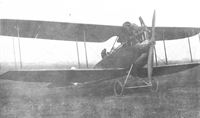В.Обухович, А.Никифоров Самолеты Первой Мировой войны
Вариант Румплер С VIII выпускался в качестве учебно-боевой машины с 1917 г. Крылья самолета были взяты от СI, а оперение - от СIV. Румплер С VIII был оснащен двигателем Аргус As.III.
Показать полностью
O.Thetford, P.Gray German Aircraft of the First World War (Putnam)
Rumpler C VIII
Although included in the C type category, the Rumpler C VIII had been developed with the intention of providing a good operational trainer for aircrews nearing the completion of their training. Previously, little equipment had been available other than the low-powered B type two-seaters and obsolete C types. The C VIII was provided to give training with emphasis on the observer's curriculum - including gunnery, observation, radio and photography - on an aircraft approaching more nearly operational standards, yet with ability to be operated economically, largely due to the installation of a 180 h.p. Argus engine.
Undoubtedly the spotlight fell upon the Jagdstaffeln, but it was the two-seater Fl. Abt. that did the donkey work in the German Air Force. With the approach of the final year of the war and the planned ultimate offensive on the Western Front for March 1918, it was hoped by the improvement and intensification of training of two-seater crews to achieve superior results, especially with more adequate protection from the Jastas and Schlachtsta formations. To facilitate this higher standard of training, the Rumpler C VIII came into use towards the end of 1917 with the F.E.A. (Flieger Ersatz Abteilungeri) "Flying Training Units".
The C VIII underwent its official Type Test at Johannisthal in November 1917, and some examples were also sold to the Dutch Government for use with their flying services.
In construction, the C VIII continued the style of its predecessors. Fuselage longerons were of ash forward, spliced into spruce in the rear half; spacers were of steel tube forward and spruce aft. The fore part of the fuselage was ply covered, except for the rounded nose panel of metal and the metal panels fairing the cylinder block; these now being much squarer than formerly. The rear part of the fuselage was fabric covered. Tail surfaces were all interchangeable with those of the C IV and C VII, with steel-tube framing and unbalanced control surfaces. The tailplane was of reversed camber section.
The wing surfaces reverted to the C I type in general shape, with both wings having angularly raked tips and being of parallel chord. The lower wing had long shallow cut-outs at the root to improve downward vision from the rear cockpit, while the upper wing had a narrow, rounded, centre-section cut-out. Conventional twin hollow box-spar construction was followed, with fretted ply ribs capped with softwood and false ribs spaced between the main ribs. Ailerons were unbalanced and of steel-tube framing. The upper wings were supported on a typical Rumpler trestle-type centre-section cabane, to which was also fixed the semicircular radiator. Both wings were swept at an angle of some 2 1/2°.
A streamlined steel-tube undercarriage chassis was fitted, and the wheels were sprung with spiral-steel springs. An orthodox steel-shod, ash tailskid was hinged to and internally sprung within the rear bay of the fuselage.
TECHNICAL DATA
Description: Two-seat operational trainer.
Manufacturer: Rumpler Flugzeug-Werke G.m.b.H., Johannisthal, Berlin (Ru.).
Engine: 180 h.p. Argus As III 6 cylinder in-line water-cooled engine.
Dimensions: Span, 12.18 m. (39 ft. 11 1/2 in.). Length, 8.02 m. (26 ft. 3 3/4 in.). Height, 3.2 m. (10 ft. 6 in.). Area, 36.2 sq.m. (391 sq.ft.).
Weights: Empty, 874 kg. (1,923 lb.) . Loaded, 1,374 kg. (3,023 lb.).
Performance: Maximum speed, 140 km. hr. (875 m.p.h.). Climb, 1,000 m . (3,280 ft.) in 4.25 min., 2,000 m. (6,560 ft.) in 11.0 min., 3,000 m. (9,840 ft.) in 21.0 min., 4,000 m. (13,120 ft.) in 37.5 min. Duration, ca. 4 hr.
Armament: One fixed Spandau machine-gun forward and one manually operated Parabellum machine-gun in the rear cockpit.
Показать полностью
J.Herris Rumpler Aircraft of WWI (A Centennial Perspective on Great War Airplanes 11)
Rumpler C.VIII
The Rumpler C.VIII was a training version of the Rumpler C.IV. To conserve high-power engines it used a 180 hp Argus As.III instead of the 260 hp Mercedes. The lower wing profile was similar to the Rumpler C.I and C.III rather than being rounded like the C.IV. The C.VIII was intended to give trainees the experience of handling a high-performance two-seater before they reached operational units instead of relying on obsolete aircraft. The C.VIII passed its Typenprufung (type test) on 24 November 1917, some 200 being ordered initially (12400/17 to 12599/17). Postwar the C.VIII was used by other countries, especially the Netherlands, which purchased 40 aircraft in April 1918.
Rumpler C.VIII Specifications
Engine: 180 hp Argus As.III
Wing: Span (Upper) 12.22 m
Span (Lower) 10.40 m
Area . 35.7 m2
General: Length 7.10 m
Height 3.20 m
Empty Weight 874 kg
Useful Load 580 kg
Loaded Weight 1,374 kg
Maximum Speed: 145 kmh
Показать полностью
P.Grosz, G.Haddow, P.Shiemer Austro-Hungarian Army Aircraft of World War One (Flying Machines)
Rumpler C.VIII (derivative)
As part of the 18 September 1917 order for six two-seat aircraft, Rumpler delivered a modified C.VII powered by a 300 hp Daimler engine (see Rumpler 00.01) in April 1918. A second Rumpler biplane, a C.VIII derivative fitted with a 230 hp Hiero engine, was reported under construction on 2 March 1918 and ready for delivery in about four weeks. It is on record that Rumpler test pilot Friedrich Budig damaged a Rumpler Type 6A8 (C.VIII), powered by a 230 hp Hiero engine, in May 1918. Other than a photograph taken at Aspern, information regarding this version is lacking.
Показать полностью











